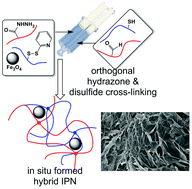In situ forming interpenetrating hydrogels of hyaluronic acid hybridized with iron oxide nanoparticles†
Abstract
Four derivatives of hyaluronic acid (HA) bearing thiol (HA-SH), hydrazide (HA-hy), 2-dithiopyridyl (HA-SSPy), and aldehyde groups (HA-al) respectively were synthesized. Thiol and 2-dithiopyridyl as well as hydrazide and aldehyde make up two chemically orthogonal pairs of chemo-selective functionalities that allow in situ formation of interpenetrating (IPN) disulfide and hydrazone networks simultaneously upon the mixing of the above derivatives at once. The formation of IPN was demonstrated by comparing it with the formulations of the same total HA concentration but lacking one of the reactive components. The hydrogel composed of all four components was characterized by a larger elastic modulus than those of the control single networks (either disulfide or hydrazone) and the three component formulations gave the softest hydrogels. Moreover, a hydrazone cross-linkage was designed to contain a 1,2-diol fragment. This allowed us to partially disassemble one type of network in the IPN leaving another one unaffected. In particular, treatment of the IPN with either sodium periodate or dithiothreitol resulted in disassembly of the hydrazone and disulfide networks respectively and thus softening of the hydrogel. Contrarily, the single network hydrogels completely dissolved under the corresponding conditions. In corroboration with this, enzymatic degradation of the IPN by hyaluronidase was also substantially slower than the degradation of the single networks. In order to further improve the mechanical properties of the elaborated injectable IPN, it has been in situ hybridized with iron oxide nanoparticles (IONPs). The mesh size of the IPN was smaller than the size of the IONPs resulting in the retention of nanoparticles in the matrix under equilibrium swelling conditions. However, these nanoparticles were released upon enzymatic degradation suggesting their use as MRI tags for non-invasive tracking of the hydrogel material in vivo. Additionally, this injectable hybridized hydrogel with encapsulated IONPs can be used in hyperthermia cancer therapy.


 Please wait while we load your content...
Please wait while we load your content...